Suzuki Swace SZ5 1.8 Hybrid
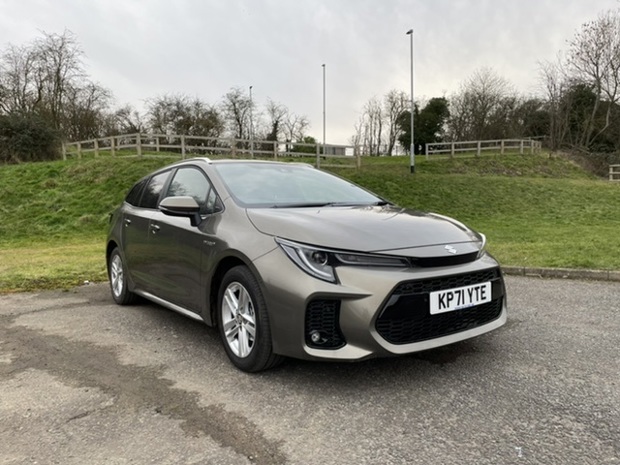
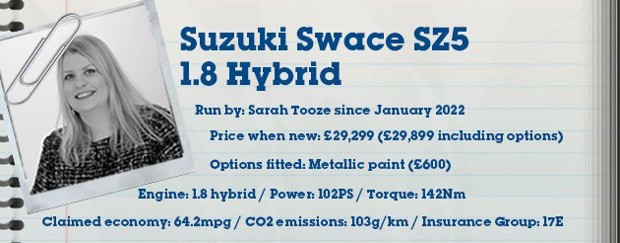
- Suzuki Swace knows how to KISS
- How practical is the Swace's boot?
- We find out what Apple CarPlay is like in the Swace
- Why the Swace is a hassle-free hybrid
- How to boost fuel economy in the Swace
- Lead times for the Suzuki Swace
- What safety technology is standard in the Swace?
- What driving modes are available in the Suzuki Swace?
- Suzuki Swace vs Toyota Corolla
- Swace’s interior is a step up for Suzuki
- Apple CarPlay lets us down in the Swace
- Final thoughts on the Suzuki Swace
Suzuki Swace knows how to KISS
With one engine and two trim levels Suzuki’s new estate knows how to ‘Keep it simple, stupid’ (KISS)

Date: 28 January 2022 | Current mileage: 1,573 | Claimed economy: 64.2mpg | Actual economy: 50.4mpg
The Suzuki Swace takes me back to my university days.
What exactly has an economical estate car that’s happiest transporting kids and the family dog got to do with being a student?
Well, the Swace reminds me of the time I was handed some guidance notes from the news editor of the student radio station. Point number one was the KISS principle: ‘Keep it simple, stupid.'
Suzuki seems to have followed the same principle with the Swace. While some manufacturers leave car buyers with a baffling array of engines, trim levels and optional extras Suzuki has given the Swace just one engine (a 1.8-litre petrol hybrid) and two trim levels: SZ-T and SZ5.
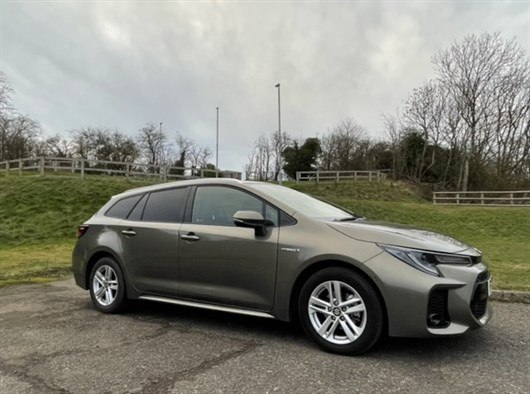
That engine comes from Toyota thanks to the partnership the two Japanese manufacturers have formed to share expertise. The Swace itself is based on the Toyota Corolla and follows the Toyota RAV4-derived Across SUV.
We'll look in detail at how the Swace stacks up against the Corolla in a future review but it's worth noting that the Corolla is priced from £25,455 and includes a five-year/100,000-mile warranty while the Swace starts at £25,499 (including a £2,000 discount).
Our top spec SZ5 costs £29,899 (including £600 for the Oxide Bronze paint) and is loaded with tech such as lane departure warning, vehicle sway warning function, blind spot monitoring, rear cross traffic alert, parking sensors, a rear parking camera and parking assist.
As we've taken delivery of the Swace in winter I've also come to appreciate the standard-fit heated steering wheel and heated seats.
How practical is the Swace's boot?
Boot space is an important reason to choose an estate car so how does the Suzuki Swace's compare to rivals?
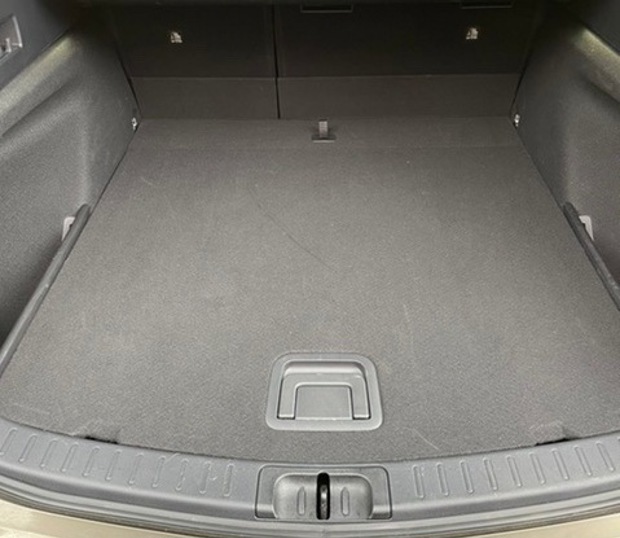
Date: 11 February 2022 | Current mileage: 1,773 | Claimed economy: 64.2mpg | Actual economy: 50.3mpg
A car’s boot space is all-important when you’re a family of three with a toddler. In smaller family cars I’ve had to fold the rear seats to fit a pushchair in but not with the Swace. I’ve found its generous 596-litre boot copes perfectly with a pushchair and the weekly shop with the seats up.
If you need more room - as we did when we went on a self-catering family holiday - the rear seats fold with a 60/40 split to give you 1,232 litres.
That’s not as big as the Skoda Octavia Estate which offers a whopping 1,700 litres with the rear seats folded and 640 litres with them up or the Hyundai i30 Tourer (602 litres and 1,650 litres, respectively) but it is, unsurprisingly, on a par with the Toyota Corolla Touring Sports on which the Swace is based.
The Swace’s boot is a practical square shape with storage compartments at either side for smaller items.

There is a long strip of auto-illuminating lights on both sides and a detachable tonneau cover that can be retracted easily.
I like the fact that the boot floor is low, making it ideal for sliding heavy suitcases in, and that it can be flipped over, giving you the choice of a carpeted floor or a resin surface (pictured above), which is more practical.
Underneath the boot floor there is even more storage space as the Swace has a puncture repair kit rather than a spare wheel (Suzuki says it isn't currently an option to specify a spare wheel on the Swace). That space proved handy on our family holiday but the idea of not having a spare wheel won't appeal to everyone.
Unfortunately it's becoming more common not to have a spare wheel in a car as there is an obvious weight-saving for manufacturers, which helps meet CO2 emissions targets. The batteries for hybrid and fully electric cars beneath the boot floor also usually restrict space.
We find out what Apple CarPlay is like in the Swace
Suzuki favours Apple CarPlay/Android Auto over a built-in sat-nav in the Swace - but is it a good move?
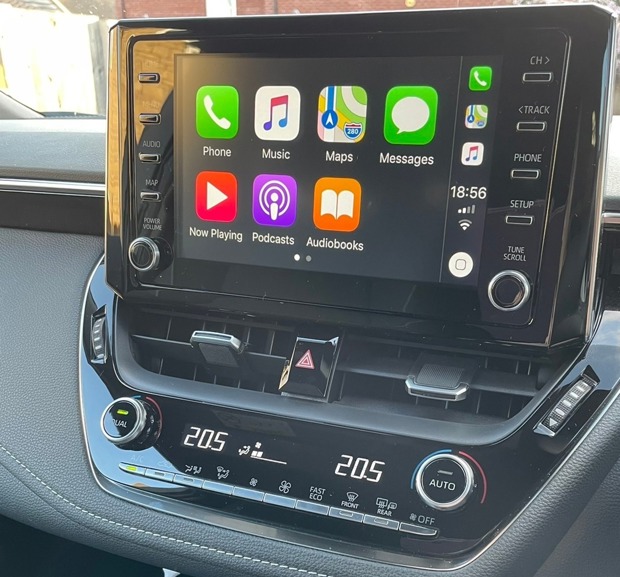
Date: 25 February 2022 | Current mileage: 1,865 | Claimed economy: 64.2mpg | Actual economy: 50.3mpg
The first time I needed to make a long journey in the Swace I was surprised to learn that it doesn’t have a built-in sat-nav, especially given that our model is the top spec SZ5.
However, it does have Apple CarPlay/Android Auto, which means you can plug your smartphone in via the USB socket and use your phone’s mapping system on the car’s infotainment screen.
Suzuki says its research has shown that more of its customers are using mapping systems via their mobile devices so it chose not to make sat-nav an option on the Swace.
So, what is Apple CarPlay like to use in the Swace? I imagined it would be seamless but the first stumbling block I came across was that I couldn’t connect my iPhone wirelessly to set it up (despite our Swace having a wireless charging pad) and I needed a standard USB-A to Lightning cable (I only had a USB-C to Lightning cable).
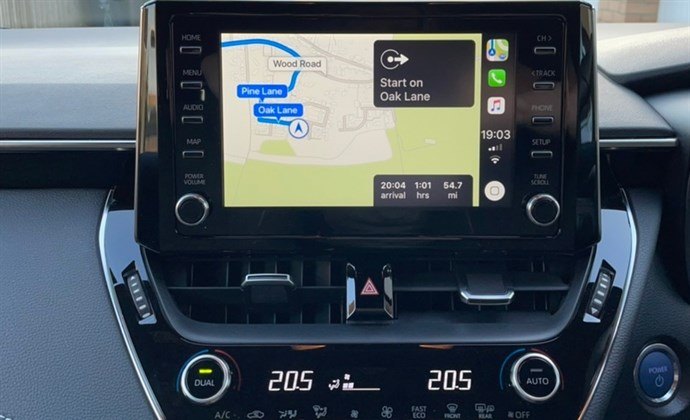
But once I had the right cable the process was straightforward. CarPlay appeared on the Swace’s screen and I could simply choose the map function and set my destination either by speaking to Siri or typing the address in on the touchscreen.
I did all this parked outside my house using my home Wi-Fi but I then needed to enable my mobile data to use CarPlay on the move. The system also won’t work if you don’t have Siri enabled.
Once set up it all worked perfectly and CarPlay is as good as any manufacturer sat-nav I’ve used. It also does away with the need to have your car sat in a cradle to use it as a sat-nav.
And there is much more to CarPlay than a mapping system. You can use it to make calls safely, have text messages read out to you or listen to music or podcasts. So if you’ve already bought into the Apple ecosystem it makes sense to extend it to your car.
Why the Swace is a hassle-free hybrid
The Swace is a self-charging hybrid but what does that mean exactly?
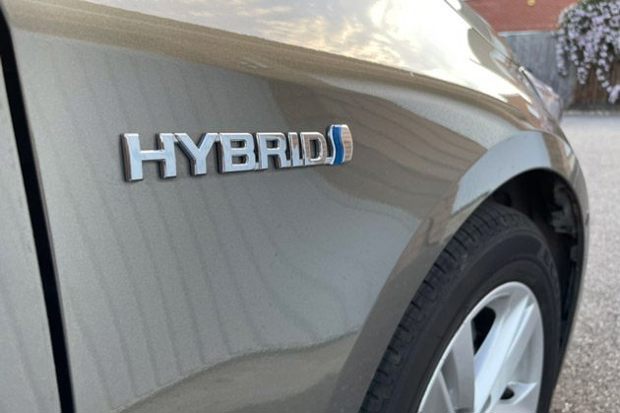
Date: 11 March 2022 | Current mileage: 1,982 | Claimed economy: 64.2mpg | Actual economy: 50.4mpg
Our Swace is a hassle-free hybrid i.e. you don’t need to plug it in to charge. It combines a 1.8-litre petrol engine with an electric motor and a battery, which is recharged when braking.
The system cleverly works out when to run on the electric motor alone, when to run on the combustion engine, or when a combination of the two is best.
If you want to see it in action, the infotainment system includes an energy monitor, which illustrates how the energy is moving to and between the petrol engine, electric motor and battery in real time.
On a separate screen, the Swace’s trip computer includes a bar graph showing the points at which energy has been regenerated.

If you want to you can put the car in EV drive mode yourself. Suzuki says this is handy for driving short distances without having to worry about noise or emissions, especially in residential areas early in the morning and late at night, or in garages and indoor car parks.
That doesn’t mean you can do your daily commute on pure electric though - unless you’re only travelling half a mile or so.
This type of hybrid is best-suited to town and city driving where the technology really comes into its own as there is plenty of opportunity for regenerative braking.
I live in a rural area, with my most regular journey being a 12-mile round trip to take my daughter to and from nursery. Unfortunately, the route doesn’t usually give me much chance for stop-start traffic so my average fuel economy is still 13mpg below the official combined figure of 64.2mpg.
How to boost fuel economy in the Swace
The Swace's driving trips have provided a welcome boost to fuel economy.
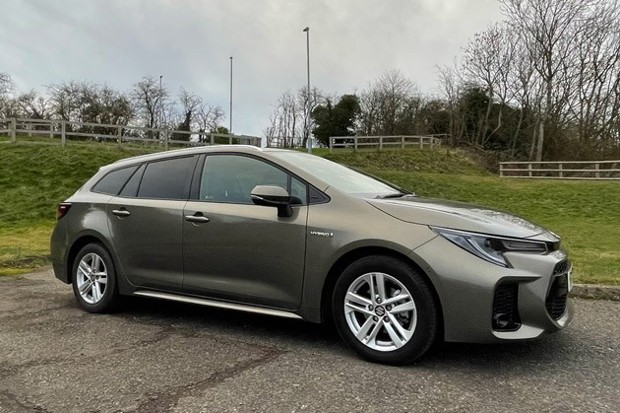
Date: 25 March 2022 | Current mileage: 2,100 | Claimed economy: 64.2mpg | Actual economy: 51.7mpg
At the end of every journey when I turn off the Swace’s engine a message pops up with my eco score and a graph showing a rating for start, cruise and stop. This is followed by tips on how to improve.
It’s a clever tactic. If it were to appear when I was concentrating on driving I might be inclined to ignore it but I can’t help but read it at the end of my journey.
I typically get around the 70 mark which I assumed was pretty good. It’s usually accompanied by a comment like ‘good, starting acceleration, decrease acceleration to improve'.
But at the end of a recent journey with my husband I looked across to see his score and was surprised: he had achieved 80. And he was told he was ‘excellent’. He could barely hide his delight when I told him how I usually fared.
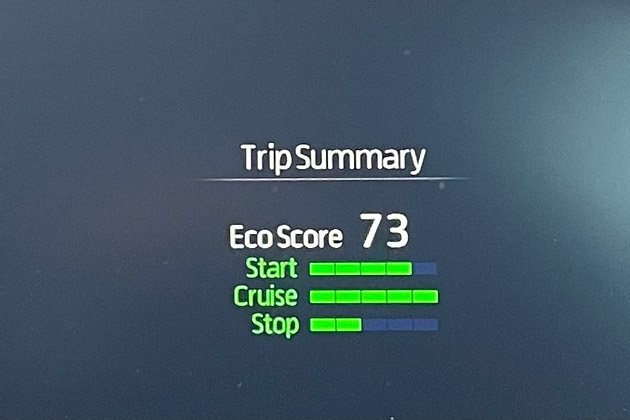
That fired me up to want to achieve my own ‘excellent’ (nothing like a bit of a healthy competition with your spouse for motivation).
So days of ultra careful driving ensued, I was light on the accelerator, kept longer than necessary gaps in traffic so I could slow down gently. And I did achieve my 80 (and a slight improvement in the average mpg).
It couldn’t have come at a better time as the average price of petrol rocketed to its highest level on 22 March of 167.3p-per-litre, closely followed by the Chancellor’s 5p fuel duty cut.
The current fuel prices are certainly making hybrid cars like the Swace more attractive.
Lead times for the Suzuki Swace
As the semiconductor shortage continues to affect new car supply we find out delivery times for the Swace.
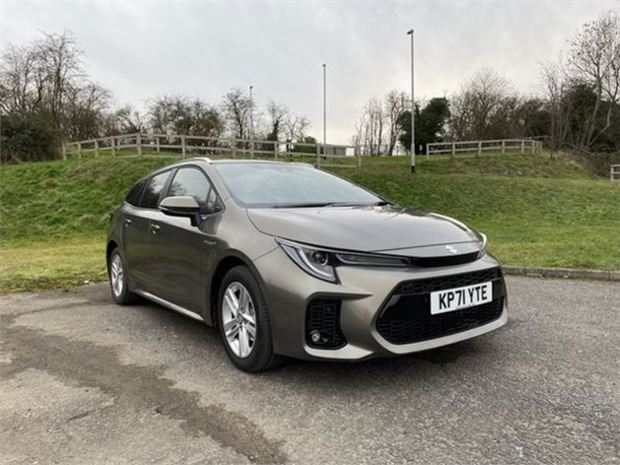
Date: 8 April 2022 | Current mileage: 2,327 | Claimed economy: 64.2mpg | Actual economy: 51.7mpg
The global semiconductor chip shortage is continuing to affect new car production, with drivers waiting up to 12 months in some cases.
And it’s not yet clear what impact Russia’s invasion of Ukraine will have on raw materials and parts supply across the automotive sector.
The general advice is if that you want a new car, get your order in as early as possible.
So how long can you expect to wait for a new Swace? A spokesperson for Suzuki told us that lead times are currently around four to five months and that there is “a good order bank for this model”.
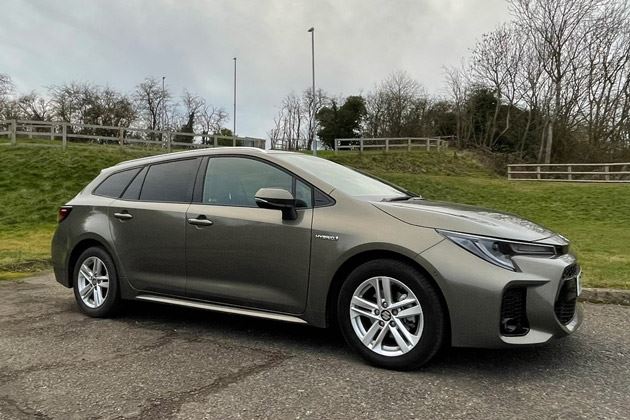
Who exactly is placing an order for the Swace? Well, with its low CO2 emissions and low benefit-in-kind tax for company car drivers it’s no great surprise that the majority of its sales are going to fleet.
Since the Swace’s launch in the UK in November 2020, Suzuki has sold 1600 units. More than three-quarters (77 per cent) have been fleet sales, with the remaining 23 per cent retail sales. This is in in line with sales projections, according to Suzuki.
But given that the car is based on the Toyota Corolla Touring Sports and the Corolla has been the best-selling car globally for years, with more than one million models solds in 2021, its appeal should grow.
We've certainly been impressed with our three months in the Swace so far. It's proving a dependable, economical car that works well for family life.
What safety technology is standard in the Swace?
Our Swace is loaded with safety technology but is it any good?
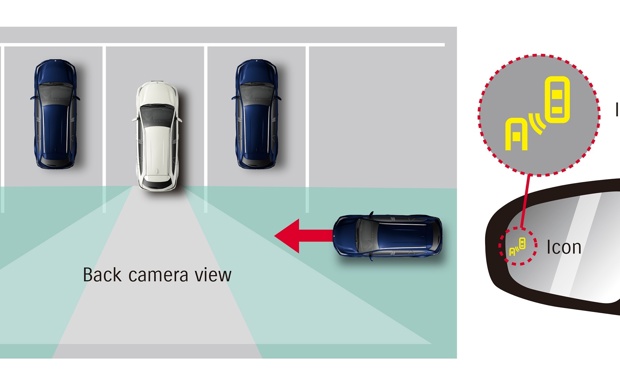
Date: 22 April 2022 | Current mileage: 2,890 | Claimed economy: 64.2mpg | Actual economy: 51.8mpg
Our Swace is loaded with safety technology - pretty much every feature you could think of (bar the kind of semi-autonomous driving functions you find in a Tesla) is fitted as standard on our top spec SZ5 model.
These include: parking assist (helps you reverse into a parking space or parallel park by providing audio and visual guidance while automatically operating the steering wheel); pre-collision system (a radar and camera monitor the road ahead and the brakes are applied to help prevent collisions with other vehicles, pedestrians or cyclists); lane tracing assist (helps to keep the vehicle in the centre of the road if it detects you’re about to leave a lane unintentionally); road sign assist (displays the road’s speed limit on the dash); dynamic radar cruise control (automatically maintains the gap from the vehicle ahead, including stopping the vehicle when the vehicle in front comes to a halt and then following it when it restarts); blind spot monitor (alerts you when a vehicle is approaching or is detected in a rear blind spot); and rear crossing traffic alert (helps you avoid collisions when reversing out of parking spaces by warning you if another vehicle is approaching in a rear blind spot).
Everything except the rear crossing traffic alert, blind spot monitor and parking assist is standard on the entry level SZ-T model, which is pretty impressive, especially as some car manufacturers bundle safety technology into packs that have to be bought as optional extras.
But are the features any good? In the main, ‘yes’. The lane departure warning definitely falls into the ‘good’ camp. I have had to turn lane departure warning systems off in some cars I’ve driven, particularly when they violently tug you back into the lane on a motorway, which can be disconcerting. Not so in the Swace, I’ve kept it on and it rarely troubles me unnecessarily.
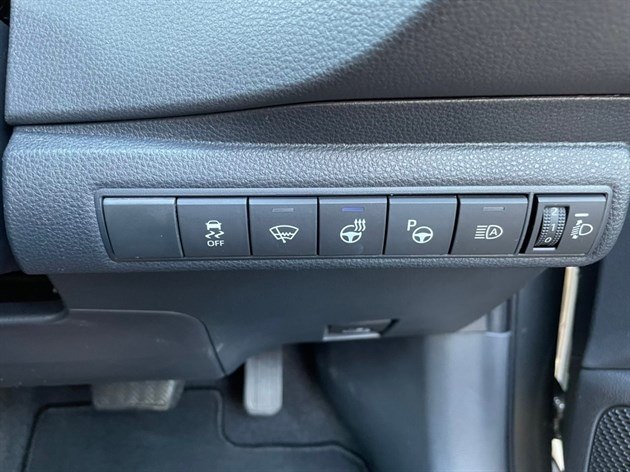
I am also a fan of the blind spot monitor, rear crossing traffic alert and parking assist. The latter is activated via a button (shown in the picture above).
Road sign assist is not so good. It works in that it always displays a speed limit. It’s just that on a few occasions the limit has been wrong. On some stretches of road it displays a 30, for instance, when the limit is 40 or 60.
That’s a good reminder that you, as the driver, should not 100 per cent rely on technology. It is there to assist (as the name suggests). However, with the EU set to introduce speed limiters in cars from July accuracy will be needed.
The other niggle is that the parking sensors are pretty loud (a complaint a tester had with a previous Suzuki). But that’s easily fixed as a message pops up asking if you would like to temporarily mute them (for the times when you don’t want to disturb your next door neighbour).
What driving modes are available in the Suzuki Swace?
We try out the Swace's three different driving modes: Normal, Eco and Sport.

Date: 6 May 2022 | Current mileage: 3,445 | Claimed economy: 64.2mpg | Actual economy: 52.6mpg
The Swace - like many cars these days - has three different driving modes: Normal, Eco and Sport, which can be chosen by flicking a switch near the gearstick.
For the four months I’ve been testing the Swace I’ve kept it in the normal driving mode. Suzuki says that this provides an optimal balance between comfort, stability and fuel economy. However, with my average mpg still stubbornly around the 51 mark - 13mpg below the official combined figure - I decided to give Eco mode a try.
This setting is supposed to enhance fuel economy through more gradual throttle response and minimal air-conditioning use, which is better than turning the air conditioning off completely (a false economy in our view as the minimal amount you might save on fuel could easily be wiped out if something goes wrong, like the compressor seizing up).
Eco mode is useful during stop-and-go city driving, according to Suzuki. In other words, it’s not the setting you want on a motorway as it does make the Swace feel constrained.
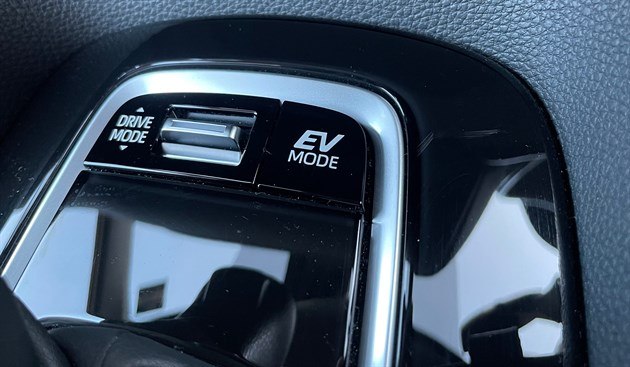
The good thing about the Swace’s Eco driving mode is that it remains in it when you restart the car. A frustration I've had with some cars is that they default to the normal driving mode so you have to remember to change it at the start of every journey.
After a week of driving in Eco mode I saw only a very modest improvement in my fuel economy (just under 1mpg) but only a few of my journeys were in city traffic.
What about Sport? Well, is there really any need for a sport setting in a sensible estate car? Suzuki says ‘yes’, for winding roads when an ‘agile driving response is desired’. This setting controls the hybrid system to provide ‘quick and powerful acceleration’. The trouble is that when you accelerate hard in the Swace, especially above 50mph, it’s a tad noisy thanks to the CVT gearbox.
After testing all the modes I’ve decided to switch back to 'Normal' as it offers the best balance of the different modes.
Suzuki Swace vs Toyota Corolla
We look at how the Suzuki Swace compares to the Toyota Corolla Touring Sports.
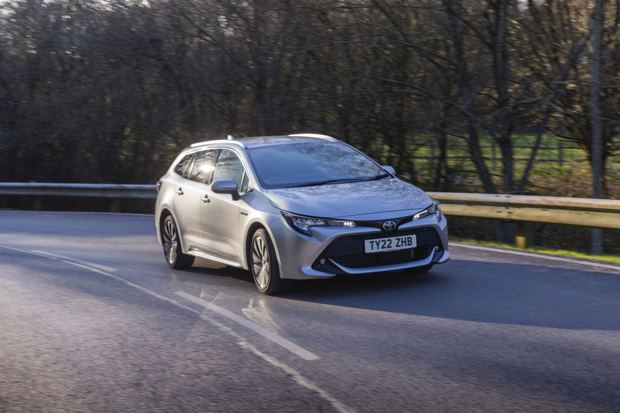
Date: 20 May 2022 | Current mileage: 3,798 | Claimed economy: 64.2mpg | Actual economy: 51.8mpg
If you’re considering buying a hybrid estate car you might be wondering how the Suzuki Swace compares to the Toyota Corolla Touring Sports on which it’s based.
Aesthetically, the biggest difference between the two cars (and when I say biggest we’re not talking a fundamental change) is that the Swace has an altered front-end design. It also has a different steering wheel. The Swace is available in seven different colours (ours is the £600 Oxide Bronze Metallic paint) while the Corolla gives a choice of eight.
When it comes to engines you’re restricted to just the 1.8-litre petrol hybrid in the Swace whereas if you opt for the Corolla you can have the more powerful 2.0-litre unit.
And when comparing trim levels, the Swace has only two: SZ-T and SZ5, while the Corolla has five: Icon, Icon Tech, Design, GR Sport and Excel. However, as I explained in my first review, I like the simplistic approach which Suzuki has taken.
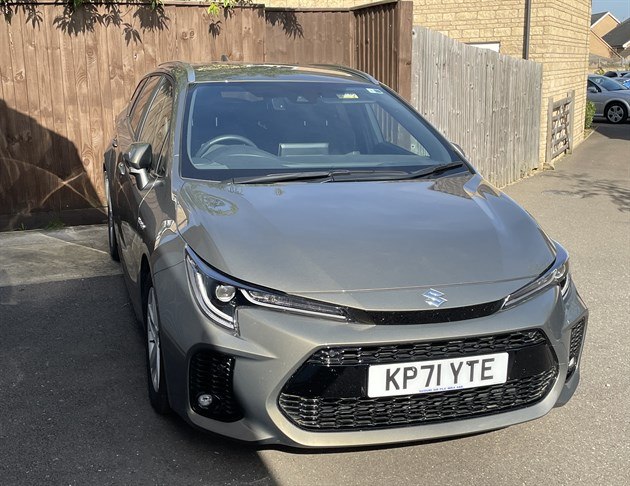
Comparing Toyota’s entry-level Icon trim with the Swace’s SZ-T reveals some notable differences. A space saver spare wheel is standard on the Corolla; in the Swace you have to make do with a tyre puncture repair kit. The Corolla features Toyota’s MyT Connected Services (which allows you to use an app on your smartphone to connect with your car and view information like the fuel level or find out where the car is parked or plan a journey and send the location to your car) but there’s no equivalent in the Swace. However, the Swace does have creature comforts like a heated steering wheel and rear privacy glass as standard.
What about price? Well, when we took delivery of the Swace in January the Corolla’s entry-level Icon was slightly cheaper at £25,455 compared to the Swace’s £25,499 (including a £2,000 discount). The latest pricing update in July sees the tables turned with the Corolla Touring Sports now starting at £28,165 and the Swace at £27,499 (with the discount no longer available).
The upfront price doesn’t tell the whole story though as warranty is an important consideration. The Swace comes with a three-year or 60,000-mile warranty but the Corolla has up to 10 years or 100,000 miles, provided you service it annually within the Toyota dealer network.
Toyota’s dealer network is, understandably, far larger than Suzuki’s which means you’re more likely to have one close by but it’s worth noting that Suzuki has a great reputation for customer service (backed up by the Institute of Customer Service). One owner told us he bought the Swace “simply because I have an excellent dealer who has served me well in the past”.
Swace’s interior is a step up for Suzuki
Soft touch materials, smart panels and a wireless phone charger make the Swace’s interior a step up from the brand’s older models.
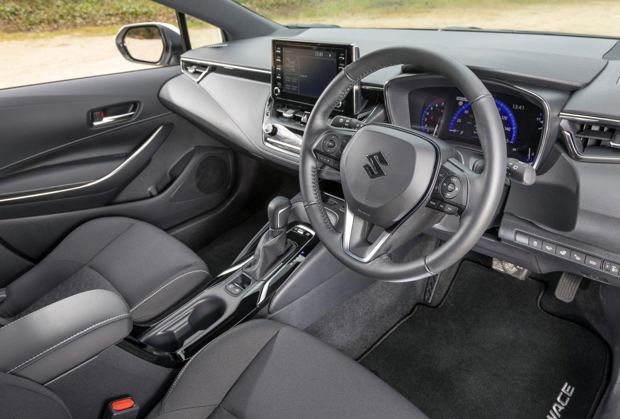
Date: 3 June 2022 | Current mileage: 4,277 | Claimed economy: 64.2mpg | Actual economy: 51.8mpg
It’s no great surprise that the Suzuki Swace’s interior is near identical to the Toyota Corolla Touring Sports on which it’s based.
That means you get the same seats, dashboard, infotainment system, and soft touch materials in both cars. The result is that the Swace feels more upmarket than some of Suzuki’s older models.
The eight-inch infotainment system has the benefit of having both a touchscreen and physical buttons either side. Similarly, the climate control panel features a row of buttons and dials, which I find easier to operate than systems which are mainly touch-sensitive.
Being easier to operate also has a safety aspect as that means your eyes are off the road for less time. The infotainment screen being positioned high up on the dashboard helps too as you simply have to glance across rather than down. Although that does means it isn’t the most attractive set-up as it juts above the dash.

The infotainment system itself isn’t cutting edge technology but with Apple CarPlay and Android Auto compatibility as standard that hardly matters.
Our top spec SZ5 includes a wireless charging pad in the front console, which is a handy edition. Except for when you need to connect your phone via the USB (to use Apple CarPlay or Android Auto) as it won’t charge wirelessly at the same time.
The seats in the Swace have proved comfortable on long journeys although to alter the angle of the backrest you have to pull a lever and shift your weight, which makes it slightly harder to find the optimum position compared with a wheel adjustment. Power adjustable lumbar support is standard, however. Heated seats and a heated steering wheel are also standard.
The Swace’s boot isn’t as big as key rivals. Find out how practical the Swace's boot is here.
Apple CarPlay lets us down in the Swace
Technical glitch makes us question whether Apple CarPlay is as good as we first thought.
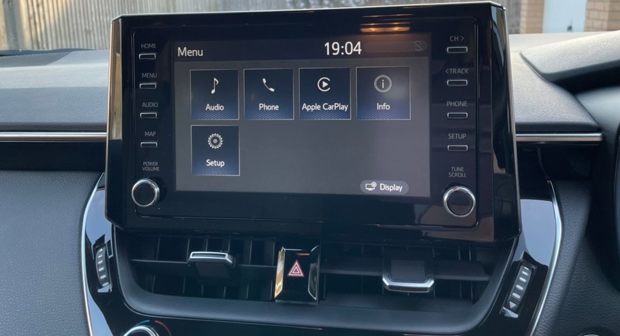
Date: 17 June 2022 | Current mileage: 4,602 | Claimed economy: 64.2mpg | Actual economy: 52mpg
My first impressions of Apple CarPlay in the Swace were positive. I said it was “as good as any car manufacturer system”. Well, I’ve had to eat my words.
Leaving Stansted Airport in the early hours of Saturday morning, the sat-nav suddenly decided it was going to stop giving me directions.
I pulled over at the nearest services, hoping the classic ‘turning the system on and off’ would fix it. It didn’t. So I had to set off again without it.

At first this wasn’t a big concern as I’ve done the journey before and it’s a fairly straightforward one. But after about 20 miles on the M11 the traffic suddenly began slowing down and then ground to a halt.
I needed to know whether to take the next nearest junction or not. Instead, the most help I could get from AppleCarPlay was the on screen message ‘the internet connection appears to be offline’.
I ended up stationary on the M11 for an hour and a half as there had been a major accident.
Did I manage to get the sat-nav working again? Yes, it turned out to be an easy fix - the settings on my phone just needed changing as it was trying to connect to Wi-Fi even though I had my data switched on. So it was not a fault with the Swace’s infotainment system. But it does make you realise that CarPlay isn't always the cover-all solution people expect it to be.
Final thoughts on the Suzuki Swace
After six months and 5,000 miles we’ve said goodbye to the Suzuki Swace, but how did it fare during our long-term test?
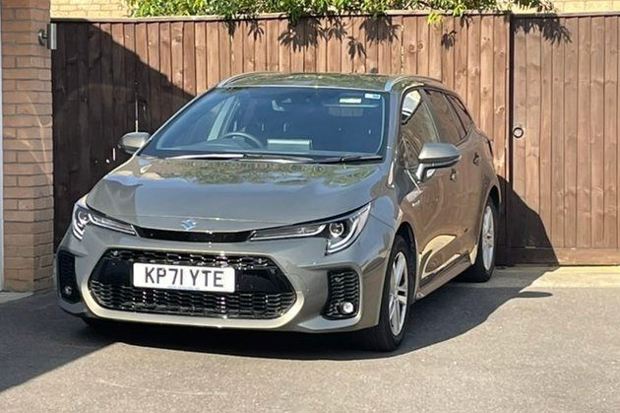
Date: 1 July 2022 | Current mileage: 5,042 | Claimed economy: 64.2mpg | Actual economy: 52.2mpg
After six months and 5,000 miles we’ve said goodbye to the Suzuki Swace.
During that time the Swace’s fuel economy increased from 50.4mpg to 52.2mpg, which is 12mpg below the official figure (64.2mpg). However, I opted to drive in Normal mode rather than Eco, and living in a rural area rather than a city centre meant I didn’t get the most out of the hybrid system as I wasn’t often in slow moving, urban traffic.
If you want to eke out the miles you can do so with the help of the Swace’s eco driving tips which appear at the end of every journey, along with an eco score out of 100. The best I achieved was a score of 80, with ultra careful slowing down and accelerating.
On longer journeys, particularly for family holidays, the Swace proved to be a comfortable, dependable workhorse. Its boot isn’t the biggest on offer from an estate car but is, unsurprisingly, on a par with the car it’s based on, the Toyota Corolla Touring Sports.

Our six months with the Swace were trouble-free, except for a technical issue I had with Apple CarPlay when I was reliant on it for a sat-nav (there is no option to specify a manufacturer sat-nav with the Swace).
My main gripe was the fact that you can’t use the wireless charging pad to charge your smartphone while your phone is plugged into the USB port. It has to be plugged in to use Apple CarPlay or Android Auto so that often makes the wireless charging pad redundant. I also found the road sign assist technology to be hit and miss, which is a common gripe with those systems.
But the rest of the safety features on the Swace were impressive, particularly as so many are standard fit. That is part of Suzuki’s approach to keeping things simple, with just two trim levels for drivers to choose from (our test car was the top spec SZ5), which is a refreshing change from the sometimes bafflingly long list of choices from other manufacturers.
However, you might be disappointed that there’s only one engine and you’ll need to opt for the Corolla if you want the more powerful 2.0-litre unit. As an affordable hybrid model, though, there's plenty to like.
